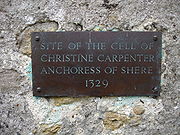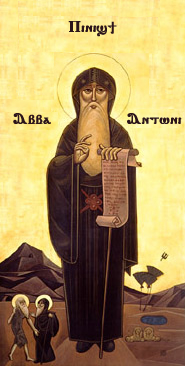
Anchorite
Encyclopedia



Eucharist
The Eucharist , also called Holy Communion, the Sacrament of the Altar, the Blessed Sacrament, the Lord's Supper, and other names, is a Christian sacrament or ordinance...
-focused life. As a result, anchorites are usually considered to be a type of religious hermit
Hermit
A hermit is a person who lives, to some degree, in seclusion from society.In Christianity, the term was originally applied to a Christian who lives the eremitic life out of a religious conviction, namely the Desert Theology of the Old Testament .In the...
, although there are distinctions in their historical development and theology.
The anchoritic life is one of the earliest forms of Christian
Christian
A Christian is a person who adheres to Christianity, an Abrahamic, monotheistic religion based on the life and teachings of Jesus of Nazareth as recorded in the Canonical gospels and the letters of the New Testament...
monastic living. Popularly it is perhaps best known from the surviving archeological and literary evidence of its existence in medieval England. In the Roman Catholic Church
Roman Catholic Church
The Catholic Church, also known as the Roman Catholic Church, is the world's largest Christian church, with over a billion members. Led by the Pope, it defines its mission as spreading the gospel of Jesus Christ, administering the sacraments and exercising charity...
today it is one of the "Other Forms of Consecrated Life" and governed by the same norms as the consecrated eremitic life.
Medieval times
The anchoritic life became widespread during the early and high Middle AgesMiddle Ages
The Middle Ages is a periodization of European history from the 5th century to the 15th century. The Middle Ages follows the fall of the Western Roman Empire in 476 and precedes the Early Modern Era. It is the middle period of a three-period division of Western history: Classic, Medieval and Modern...
. Examples of the dwellings of anchorites and anchoresses survive. They tended to be a simple cell (also called "anchorhold"), built against one of the walls of the local village church. In the Germanic lands from at least the tenth century it was customary for the bishop to say the office of the dead as the anchorite entered her cell, to signify the anchorite's death to the world and rebirth to a spiritual life of solitary communion with God and the angels. Sometimes, if the anchorite was walled up inside the cell, the bishop would put his seal upon the wall to stamp it with his authority. But some anchorites freely moved between their cell and the adjoining church.
Hearing Mass
Mass (liturgy)
"Mass" is one of the names by which the sacrament of the Eucharist is called in the Roman Catholic Church: others are "Eucharist", the "Lord's Supper", the "Breaking of Bread", the "Eucharistic assembly ", the "memorial of the Lord's Passion and Resurrection", the "Holy Sacrifice", the "Holy and...
and receiving Holy Communion was possible through a small, shuttered window in the common wall facing the sanctuary, called a "hagioscope
Hagioscope
A hagioscope or squint, in architecture, is an opening through the wall of a church in an oblique direction, to enable the worshippers in the transepts or other parts of the church, from which the altar was not visible, to see the elevation of the host.Hagioscopes were also sometimes known as...
" or "squint". There was also a small window facing the outside world, through which the inhabitant would receive food and other necessities and, in turn, could provide spiritual advice and counsel to visitors, as the anchorites gained a reputation for wisdom.
Anchorites were supposed to remain in their cell in all eventualities. Some were even burned in their cells, which they refused to leave even when pirates or other attackers were looting and burning their towns. They ate frugal meals, and spent their days both in contemplative prayer and interceding on behalf of others. Anchorite hymns such as Ignus Lux Sanctum, praising the sanctity of light in all its forms, were the inspiration for Athanasius Kircher
Athanasius Kircher
Athanasius Kircher was a 17th century German Jesuit scholar who published around 40 works, most notably in the fields of oriental studies, geology, and medicine...
's research on optics and magnetism. Anchorites' bodily waste was managed by means of a chamber pot
Chamber pot
A chamber pot is a bowl-shaped container with a handle, and often a lid, kept in the bedroom under a bed or in the cabinet of a nightstand and...
. An idea of their daily routine can be gleaned from an anchoritic Rule known as Ancrene Wisse
Ancrene Wisse
Ancrene Wisse or Guide for Anchoresses is an anonymous monastic rule for anchoresses, written in the early 13th century. Ancrene Wisse was originally composed for three sisters who chose to enter the contemplative life...
.
One very well known medieval anchoress is Julian of Norwich
Julian of Norwich
Julian of Norwich is regarded as one of the most important English mystics. She is venerated in the Anglican and Lutheran churches, but has never been canonized, or officially beatified, by the Catholic Church, probably because so little is known of her life aside from her writings, including the...
, whose writings have left a lasting impression on Christian spirituality. All Saints' Church in King's Lynn, Norfolk, still has its original 12th century Anchorhold, intact and still very much in use during the daily worship of the church.
See also
- AsceticismAsceticismAsceticism describes a lifestyle characterized by abstinence from various sorts of worldly pleasures often with the aim of pursuing religious and spiritual goals...
- Book of the First MonksBook of the First MonksThe Book of the First Monks is a medieval Christian work in the contemplative and eremetic tradition of the Carmelites. It is one of the most important documents of the Order, because it shaped many of the Saints from the Carmelite Order in the basic spirituality of the first Hermits...
- Cenobite
- Christian monasticismChristian monasticismChristian monasticism is a practice which began to develop early in the history of the Christian Church, modeled upon scriptural examples and ideals, including those in the Old Testament, but not mandated as an institution in the scriptures. It has come to be regulated by religious rules Christian...
- Consecrated lifeConsecrated lifeThe consecrated life in the Christian tradition, especially the Roman Catholic Church, but also the Anglican Church and to some extent other Christian denominations, is, as the Roman Catholic Code of Canon Law states: "a stable form of living by which faithful, following Christ more closely under...
- HermitHermitA hermit is a person who lives, to some degree, in seclusion from society.In Christianity, the term was originally applied to a Christian who lives the eremitic life out of a religious conviction, namely the Desert Theology of the Old Testament .In the...
- NaziriteNaziriteIn the Hebrew Bible, a nazirite or nazarite, , refers to one who voluntarily took a vow described in . The term "nazirite" comes from the Hebrew word nazir meaning "consecrated" or "separated"...
- ShugendōShugendois a highly syncretic Buddhic religion or sect and mystical-spiritual tradition which originated in pre-Feudal Japan, in which enlightenment is equated with attaining oneness with the . This perception of experiential "awakening" is obtained through the understanding of the relationship between...
- SadhuSadhuIn Hinduism, sādhu denotes an ascetic, wandering monk. Although the vast majority of sādhus are yogīs, not all yogīs are sādhus. The sādhu is solely dedicated to achieving mokṣa , the fourth and final aśrama , through meditation and contemplation of brahman...
- Stylite
Historical development
- Diocese of Kerry - Skellig Michael
- The Anchorhold at All Saints Church, King's Lynn, Norfolk
- Chapter 1 of The Rule of Saint Benedict re: Anchorites
- The Way of an Anchoress
- Anchorite Cell at St Luke's Church in Duston
- Marsha, Anchoritic Spirituality in Medieval England: The Form, the Substance, the Rule
- Rotha Mary Clay, Full Text plus illustrations, The Hermits and Anchorites of England.
- Rotha Mary Clay, The Hermits and Anchorites of England, Chapter VII: Anchorites in Church and Cloister
- Ancrene Wisse, Introduction
- anchorite?

